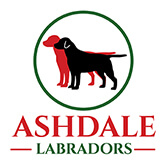Genetic Diseases In The Labrador Retriever |
Hip DysplasiaHip Dysplasia is associated with abnormal joint structure and a laxity of muscles, connective tissue and ligaments that would normally support the joint. As joint laxity develops, the articular surfaces of the 2 bones lose contact with each other. This separation of the two bones is called subluxation, and this causes a drastic change in the size and shape of the articular surfaces. Most dysplasic dogs are born with normal hips but due to their genetic makeup [and possibly other factors such as inappropriate diet, exercise and trauma], the soft tissues that surround the joint develop abnormally, causing the subluxation. It is this subluxation and remodelling of the hips that leads to the symptoms of the disease. Hip Dysplasia may or may not affect both the right and/or left hip. Affected dogs often walk or run with an altered "bunny hop" gait, and may resist movements that require full extension or flexion of the rear legs. They will also show stiffness and pain in the rear legs after exercise or first thing in the morning. Responsible breeders X- ray their potential breeding stock at 12 months and both the left and right hip are assessed by a veterinary panel. Each hip is scored between 0 and 53, according to the amount of joint laxity changes seen. A score of zero reflects no abnormal changes whilst the higher the score, the more joint changes are present. The score of each hip is added together to give a total out of 106. Single digit scores are generally accepted as suitable for breeding. |
Elbow DysplasiaElbow Dysplasia is a generic term meaning arthritis of the elbow joint. It can cause lameness in young large breed dogs and is commonly found in both elbows. X rays of the elbow joint from 12 months of age allow a veterinary panel to assess the presence, if any, of arthrosis. Scoring for Elbow Dysplasia is divided into 5 grades. 0: No Evidence of dysplasia
|
Progressive Retinal Atrophy [PRA, PRCD]PRA is the progressive degeneration of photoreceptors [rods and cones] in the dog's eye causing degenerative abrasions of the retina, resulting in blindness. PRCD is a late onset form of PRA, however there is a variation of the age of onset between the many breeds it affects. While the disease is not fatal and has late onset, the resulting blindness may decrease the quality of life for both you and your dog. The initial symptom of PRCD is usually night blindness, as the degeneration of the retina affects the rods, reducing visual abilities in dim light. Night blindness usually progresses to day blindness quickly, as the cones in the eye are sensitive to bright light deteriorate. Sadly, PRA regularly leads to blindness, for which there is no treatment or cure. PRCD is an autosomal recessive disease. A recessive trait or disease will only be expressed when TWO copies of the variant gene are present. A dog with 2 copies of the recessive gene is AFFECTED, they will present with symptoms and pass a copy of the variant gene to their ofspring 100% of the time. A dog with 1 copy of the recessive gene is a CARRIER. They will never present with symptoms but will pass the variant gene onto their offspring 50% of the time. A dog that does not have any copies of the recessive variant gene is CLEAR and will never produce affected offspring. Please note that a CARRIER is as clinically sound as a CLEAR dog, but care needs to be taken to make sure that the CARRIER is bred to a CLEAR dog to ensure that the resultant puppies are not AFFECTED. A carrier to carrier mating and an affected to carrier mating runs the risk of producing affected puppies. All of my breeding stock are CLEAR, so they can only produce CLEAR offspring. |
Retinal DysplasiaRetinal dysplasia is a congenital defect which in its simplet form is seen as a multiple folding of the retina, while the most severe type is non- attachment of the retina to the underlying choroid. The effect on sight varies accordingly, ranging from no apparent defect to total blindness. At present there is no DNA test to determine a breeding dogs status for this condition. Annual eye checks are carried out by a veterinary opthalmologist and an eye certificate issued each year which reports on any abnormal findings. |
Exercise Induced CollapseExercise Induced Collapse is an intolerance to strenuous exercise. Affected dogs can tolerate mild to moderate exercise but 5 to 15 minutes of strenuous exercise induces weakness and then total collapse. Weakness starts in the rear limbs but then progresses rapidly to the frorelimbs, resulting in a weak, wobbly gait. Dogs ultimately collapse and are unable to continue exercising. After 10 to 30 minutes of rest, however they return to normal. A few affected dogs have died during exercise or while resting after an episode of EIC. Symptomatic dogs are rarely able to continue training or competition. It seems that if affected dogs are removed from training and not exercised excessively the condition will not progress and they will be fine as pets. A genetic test is available to establish the EIC status of breeding stock. A CLEAR dog does not have a copy of the gene and will never present with symptoms or produce an affected offspring. A CARRIER dog is clinically sound and will never present with symptoms. However, these dogs carry the gene for EIC and can pass the gene on to their offspring. They must only be bred to a CLEAR partner. AN AFFECTED dog has the disease and will usually present with symptoms if over exercised. |



